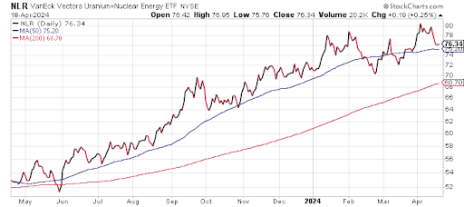In the popular discourse, renewable energy is synonymous with solar, wind, tidal, or even geothermal power. What’s often left out of the conversation is nuclear power.
That omission is understandable. After nuclear energy stocks rallied 50% out of the Great Recession, the world witnessed the meltdown of the Fukushima reactor following the Great East Japan Earthquake.
That tragedy prompted major nations, including Japan and France, to pledge to end their reliance on nuclear power.
In response, nuclear energy stocks dropped by half, and nuclear power dropped out of the renewable energy discussion.
Even years later, nuclear is still not top-of-mind when people think about solving global warming.
But smart money has been moving into the sector as safety and technological advances promise a new era for nuclear power – one of smaller, more powerful, safer plants. As the following chart of the VanEck Uranium and Nuclear Energy ETF (NLR) shows, the sector is now trading near 52-week highs.
The fundamental reason is the long-term trend toward decarbonization. Nuclear energy can play a vital part since it remains the most compact way to deliver massive amounts of electrical power. In the short term, however, Russia’s aggression in Ukraine is causing much of Europe to reconsider the role of nuclear energy.
Nuclear already produces 10% of the world’s electricity (20% in the U.S.). Japan and France have reversed their post-disaster plans to cut back and, the International Energy Agency outlined a 10-point plan to reduce EU reliance on Russian fossil fuels, including maximizing nuclear output. And, to be clear, the industry has implemented many safety measures in response to Fukushima to avoid the cascade of problems that led to that failure.
One particular technological development has me particularly excited.
A Smaller, More Efficient Nuclear Reactor
It’s HALEU. That’s an acronym for high-assay low-enriched uranium. It allows for smaller and more efficient reactors. It’s seen as the future of the industry, both for new reactors and for extending the life of existing reactors.
Right now, commercial nuclear reactors use low-enriched uranium, in which less than 5% of the uranium mass is the U-235 isotope that generates energy. On the other end of the spectrum is highly enriched uranium, where up to 90% of the uranium is the U-235 isotope. It’s used by U.S. Navy ships and subs, as well as some research reactors.
HALEU is in between, with 5% to 19.75% of the uranium mass that power-source isotope. As an added bonus, HALEU can be made from down-blending the used, military-grade uranium. Power plants will be smaller, more efficient, produce less waste uranium and they won’t need their cores replaced for 20 years, unlike every 18 to 24 months for current reactors. At the moment, the DOE is in the process of deciding on the next-generation reactor from 10 finalists; nine of them are designed to use HALEU.
The first market for HALEU will be micro-reactors for the military. The Pentagon is seeking to remove domestic bases from the wider electrical grid as part of its climate change-related plans to keep bases operational under increased extreme weather events. A Defense Department prototype reactor, Pele, should be available in 2024. Perhaps 130 reactors will be deployed. By mid-decade, utility-owned micro-reactors will start rolling out for remote locations like interior Alaska and far-flung islands. They’ll generate perhaps 10 megawatts (MW) of energy with a one-time upfront fueling to last 20 years. More powerful, advanced utility reactors could come to market by 2030. Even current reactors will be able to use HALEU in place of the low-enriched stuff.
What has me especially excited about this development is, by rule, the U.S. military needs to find a domestic supplier of HALEU to fuel those Pele reactors. Plus, the federal government wants to re-shore uranium refining. Political winds can change, but both recent Republican-led administrations and the Biden administration call HALEU an issue of national energy security. The government is even exploring a strategic uranium supply.
Meeting HALEU Demands
Right now only one company will be able to meet American needs: Centrus Energy (LEU). An Ohio company, Centrus is building the only U.S. facility that will be licensed to produce the high-assay uranium. The federal government is paying the bulk of the cost of the initial facility under a contract, which later can be expanded modularly to meet demand. Centrus already produces low-enriched uranium, and generates $320 million a year in sales to U.S., European and Asian utility customers.
But HALEU is where the growth will come from: Based on a survey the Nuclear Energy Institute conducted of U.S. advanced reactor developers, it is possible the market for HALEU could be worth $1.2 billion annually by 2030 and $5.6 billion by 2035, based on the low-end price of HALEU (in Europe) today. Centrus has non-binding agreements to produce HALEU for reactors planned by private businesses to come online by the end of the decade.
And LEU shares are up 34% in the last year while the company trades at a forward price-to-earnings ratio of 13.

